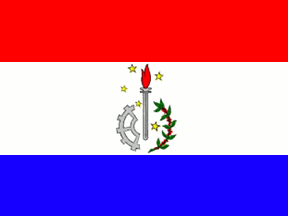 image by
Dirk Schönberger,
14 February 2013
image by
Dirk Schönberger,
14 February 2013 Based on: http://pt.wikipedia.org/wiki/Tamba%FA

Last modified: 2013-02-25 by ian macdonald
Keywords: sao paulo | tambaú |
Links: FOTW homepage |
search |
disclaimer and copyright |
write us |
mirrors
 image by
Dirk Schönberger,
14 February 2013
image by
Dirk Schönberger,
14 February 2013
Based on:
http://pt.wikipedia.org/wiki/Tamba%FA
A horizontal tricolour, red-white-blue, ratio 2-3-2, bearing the municipal arms on the central stripe.
Official website at
http://www.tambau.sp.gov.br
Dirk Schönberger,
13 February 2013
Originally living from the monoculture of sugarcane, and, subsequently, of coffee, Tambaú turned into an industrial town in the early 20th century. Supplied with local clay, the first ceramic factory was built in 1905; the tilery inaugurated in 1917 inaugurated the Tambaú Ceramic Pole. The town is known today as "Ceramic Town".
http://www.camaratambau.sp.gov.br/breve-historica.html - Website of the Municipal Council
[The original source is the website of the Municipal Council]
The symbols of Tambaú are prescribed by Article of the Municipal Constitution, adopted on 5 April 1990, as "the flag (Decree Law No. 143 of 17 July 1972), the coat of arms (Law No. 341 of 10 November 1961), and the anthem (Law No. 338 of 20 September 1961)".
http://www.camaratambau.sp.gov.br/images/stories/LOA/LOM2012.pdf - Municipal Constitution
The flag is horizontally divided red-white-blue (2:3:2) with an emblem (not the municipal coat of arms) in the middle.
Red is a symbol of heroism and courage, recalling the tenacity of the pioneers who settled in Tambaú, as well as the force and vigour of their followers, who still contribute today to the general progress of the town. Red also represents the soil (red-brown and dark red latosol), on which the town was built. White represents the aspiration of the people to live in "Labour and Religion". It is also the colour of the sandy soils of the fields and hills (red and yellow latosol, regosol). Blue is a symbol of dedication, fidelity and patriotic love.
The emblem is made of a silver torch with a dark red flame, surrounded in base dexter by a half cogwheel argent and sinister by a branch of coffee, and by a yellow Southern Cross. Red dark is a symbol of knowledge. Yellow is a symbol of nobleness, magnanimity, and integration of all Brazilians in a common country.
http://www.camaratambau.sp.gov.br/bandeira.html - Website of the
Municipal Council
Ivan Sache, 15 February 2013